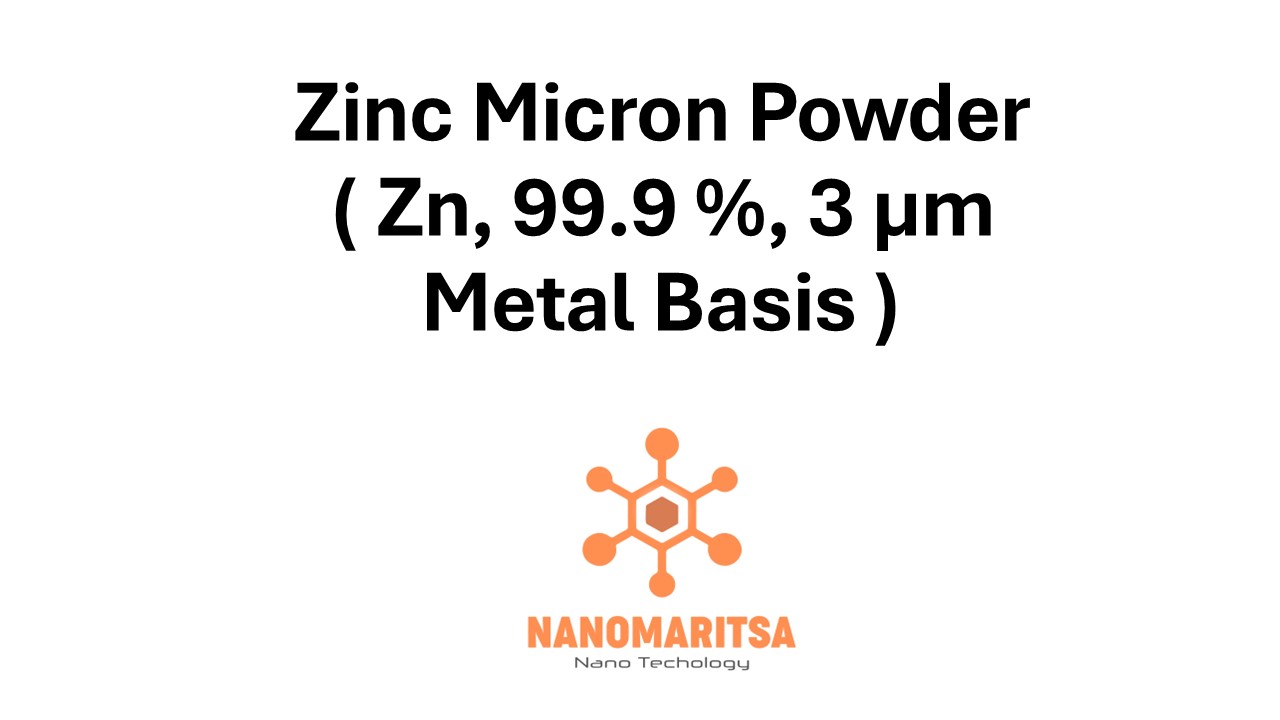Zinc Micron Powder (Zn, 99.9%, 3 µm, Metal Basis) is a high-purity zinc powder featuring an ultrafine particle size of about 3 micrometers. With its metallic luster, good corrosion resistance, and ease of alloying, zinc plays a vital role across diverse industries—from protective galvanizing and battery electrodes to chemical catalysts and pharmaceuticals. The 99.9% purity ensures minimal contamination, while the 3 µm particle size provides a high surface area that benefits applications requiring consistent reactivity and dispersion, such as powder metallurgy, coatings, and additive manufacturing.
1. Key Properties
- High Purity (99.9%)
Minimizing impurities is crucial in advanced applications like battery production, chemical processing, and electronic components, where contamination can affect product performance and quality. - Fine Particle Size (3 µm)
An ultrafine micron size delivers a high surface-to-volume ratio, boosting chemical reactivity and enabling uniform blending in composites, pastes, and coating formulations. - Corrosion Resistance
Zinc naturally forms a protective oxide film that helps prevent further corrosion, a property leveraged in galvanizing steel and other anti-corrosion treatments. - Good Alloying Behavior
Zinc easily alloys with aluminum, copper, and other metals, enabling the creation of specialized materials with enhanced mechanical and chemical properties. - Electrochemical Activity
In batteries (e.g., zinc-air, zinc-carbon), zinc’s stable electrochemical performance provides reliable energy discharge, making it a staple in various portable power solutions.
2. Applications
- Galvanizing & Coatings
Zinc’s primary role in protecting steel against rust is well-known. Fine zinc powders contribute to cold galvanizing paints and protective coatings for extended component lifespan. - Battery Electrodes
Ultrafine zinc particles can enhance electrode performance in zinc-based batteries, offering higher surface reactivity and potentially improving discharge rates or cycle life. - Powder Metallurgy
Used as an alloying or binding agent, zinc powder helps produce parts with improved wear resistance, mechanical strength, and corrosion protection in industries like automotive or tools. - Additive Manufacturing (3D Printing)
While less common than some other metals, zinc powder is being explored for specialized additive manufacturing applications, where lower melting points can simplify production processes. - Chemical Catalysts
Thanks to zinc’s reactivity, it appears in catalysts or reagents involved in organic syntheses, rubber compounding, and plastic stabilizers, contributing to efficient chemical transformations. - Pharmaceutical & Nutritional Products
In carefully controlled forms, zinc powder or compounds are used for dietary supplements and pharmaceutical formulations, supporting various metabolic functions and immune health.
3. Advantages
- Enhanced Reactivity
The 3 µm particle size maximizes surface contact in chemical reactions—particularly advantageous in battery electrodes, catalysts, and metal-polymer composites. - Uniform Dispersion
Fine, consistent powder morphology aids in blending with other materials, minimizing clumping and ensuring homogenous microstructures in sintered or molded components. - Corrosion Protection
Zinc’s ability to form a protective patina underpins its widespread use in galvanizing, extending product durability in outdoor, marine, and industrial environments. - Electrical Conductivity
Although not as conductive as copper, zinc’s respectable conductivity and compatibility with other metals make it suitable for certain electronic applications or conductive coatings. - Versatile Manufacturing
From powder metallurgy to plating solutions, zinc powder integrates into multiple production methods, providing flexibility and cost-effectiveness in bulk processes.
4. Recent Trends and Research
- Advanced Battery Technologies
Researchers are refining zinc-air and zinc-ion batteries, focusing on improving energy density, rechargeability, and environmental friendliness. - Innovative Coating Formulations
Protective zinc-rich coatings with nanostructured additives or binders improve adhesion, scratch resistance, and anti-corrosion performance. - Zinc-Based Alloys in 3D Printing
As additive manufacturing expands, efforts to adopt zinc for low-temperature metal printing—potentially lowering production costs—continue to gain traction. - Green Manufacturing & Recycling
Enhanced recycling of zinc from scrap metal, batteries, and galvanizing byproducts supports circular economy initiatives, aligning with global sustainability goals. - Biomedical & Nutritional Research
New studies explore zinc’s role in wound healing, immune modulation, and as a biodegradable metal in medical implants—particularly in orthopedics or regenerative medicine.
5. Future Prospects
- High-Capacity Zinc Batteries
The pursuit of cleaner, more affordable energy storage may see zinc-based batteries become a strong contender in large-scale grid applications and consumer electronics. - Lightweight Zinc Alloys
Automotive and aerospace manufacturers looking to cut weight and maintain strength could embrace advanced zinc-aluminum or zinc-magnesium alloys. - Enhanced Durability Coatings
More robust zinc coatings with advanced polymer binders can offer next-level corrosion protection, catering to extreme service environments (offshore, industrial plants). - Medical Innovations
As research continues, zinc powder’s high purity and fine particle size may further expand its use in biodegradable implants, targeted drug delivery systems, and skin treatments. - Hybrid Manufacturing Processes
Combining sintering, additive manufacturing, and novel bonding methods could unlock new applications for zinc powder in custom part designs and miniature electronic circuits.
By uniting 99.9% purity with a 3 µm particle size, Zinc Micron Powder (Zn, 99.9%, 3 µm, Metal Basis) provides a robust, corrosion-resistant, and highly reactive raw material for a wide array of industrial and technological applications. Whether enhancing the anti-corrosive properties of steel, powering next-generation batteries, or facilitating precision metal parts in powder metallurgy, zinc’s versatile nature ensures its enduring importance in modern manufacturing and future innovations.
| Measurement (gr) | 100 grams, 500 grams, 1000 grams |
|---|






